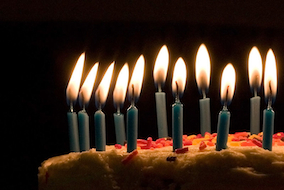In my third column on Wonder Woman, I wrote that “I was never really interested in superheroes as a kid,” mostly because the superhero genre contained, in my opinion, nothing but “a bunch of beefy men beating each other up.” I still hold true to the original intent of my statement, but I realize that I neglected to mention one superhero I did like as a kid: Sailor Moon.
Like many other so-called “nineties kids,” I fell in love with Sailor Moon when she made her US debut. For those who don’t know, Sailor Moon is a manga- turned-anime about a middle-school girl named Usagi who discovers she must take on the role of the “pretty guardian of love and justice” Sailor Moon. The Sailor Scouts (other girls taking up the mantle as other guardians) help in Sailor Moon’s quest to keep evil-doers from enslaving humanity. Each girl has her own set of powers and a planet that she represents (Mars, Mercury, Jupiter, etc.). Sailor Moon was a role model of mine growing up. I asked for Sailor Moon dolls and toys at every holiday and as rewards for good grades. I remember my feelings of betrayal and loss when the Cartoon Network announced its cancellation of the series. (Suffice it to say that I have my nostalgia glasses on for this piece. Who said I had to be objective, anyway?)
The biggest reason I admired Sailor Moon as a kid, I think, is because not only was she a good role model, but this status was something I could attain. All of the Sailor Scouts had likeable, recognizable personalities. The writer in me today acknowledges that they are a bit flat—Ami is the “smart one,” Makoto is the “athletic one,” etc.—but nevertheless, each girl possessed qualities and characteristics I could recognize in myself. Ami was successful in school but shy, Minako was sweet and caring toward others, and so on. None of them were perfect. Usagi often cried when things went wrong, she and Minako both got poor grades in school, and battles with an enemy were often clumsy and uncoordinated. These combinations of both positive and negative characteristics made the Sailor Scouts attainable to me. If I tried hard enough, I could be just like them: I could be strong and cool and defeat evil with a flick of my hair and a magic pen.
Another aspect of Sailor Moon I admired (and continue to admire as a grown-up feminist today) was how the show fully embraced femininity. The Sailor Scouts all wear schoolgirl uniforms in battle, but this outfit was used more to illustrate the power of femininity than to sexualize the main characters for the male gaze. While I admit their uniforms are a bit impractical—those long legs are certainly exposed to damage, not to mention the difficulty of running in high heels and heeled boots—they’re just another symbol of Sailor Moon’s main message: femininity is not only okay, it is powerful. Sailor Moon and her companions are able to defeat evil forces with attacks like “Moon Tiara Magic” and “Starlight Honeymoon Therapy Kiss” and with weapons like “Spiral Heart Rod” and “Cutie Moon Rod.” Although the Sailor Scouts have their occasional squabbles, they put them aside and work together. The girls are all very strong friends and support each other no matter what: while they do argue, they do not resort to cattiness or gossiping in the way that women (especially young women) are often depicted as doing in other shows. Additionally, the Sailor Scouts are not dependent on men to save them or to fix their problems. The show does have male characters (notably Tuxedo Mask, Sailor Moon’s love interest), and the girls often talk about boys and crushes, but when it comes down to it, they rely more on each other than on any man. While Tuxedo Mask does swoop in and save Sailor Moon at a critical point in battle in several of the early episodes, he leaves immediately afterward. (I like to joke with friends of mine who watch the show that Tuxedo Mask is basically useless, but he deserves a little credit.) As the series continues, Sailor Moon needs Tuxedo Mask less and less, growing into her responsibility and proving that she (literally) can fight her own battles. She is not ashamed of or seeks to repress her femininity but rather, she embraces it for its power.
Sailor Moon also examines sexuality and gender identity/presentation. Two Sailor Scouts that join the team later in the series, Sailor Uranus/Haruka and Sailor Neptune/Michiru, are involved in a lesbian relationship. The two are candid about their relationship and do not attempt to hide it from anyone. Haruka is also “dual gendered,” as Martha Cornog and Timothy Perper put it. She dresses in masculine clothes and flirts with the other Sailor Scouts, several of whom mistake her for a man and develop crushes on her. When Usagi asks Haruka if she is a boy or girl, Haruka replies, “Does it matter?” In the last arc of the series, a group called the Sailor Starlights join the team in their fight against evil. While the Starlights are presented as female, they dress as men when on Earth among civilians. The anime takes this one step further: when among civilians, the Starlights take on biologically male characteristics. Sailor Moon blurs the lines of both gender and sexuality, challenging the heteronormative cliches that populate media aimed at girls.
At its core, Sailor Moon is a feminist text. The manga was written by a woman for young women and teenage girls, but not in a way that caters to patriarchal expectations or stereotypes. Sailor Moon does not talk down to its audience by assuming they only care about boys and makeup. It treats them as conscious and intelligent, and that’s one reason the series has been so successful. As Kathryn Hemmann argues, “In a landscape of Disney princesses concerned primarily about the men in their lives, the Sailor Moon manga and anime series were a rare oasis of female characters not defined by their attachment to men or involvement in romance.” For me and many others, Sailor Moon remains the epitome of girl power.
##
Works Cited:
Cornog, Martha and Timothy Perper. “Non-Western Sexuality Comes to the U.S.: A Crash Course in Manga and Anime for Sexologists.” Contemporary Sexuality, vol. 39, no. 3, March 2005, pp. 1-6.
Hemmann, Kathryn. “Short Skirts and Superpowers: The Evolution of the Beautiful Fighting Girl.” U.S.-Japan Women’s Journal, no. 47, 2014, pp. 45-72. https://muse.jhu.edu/article/578913



 I remember my first kiss. The smell of his bad breath. The awkward way his tongue darted around my mouth and my urge to wipe his saliva off my face the first chance I got. I remember thinking how weird it was to let someone stick their tongue in my mouth. Wondering how long we were going to kiss. I remember feeling nothing.
I remember my first kiss. The smell of his bad breath. The awkward way his tongue darted around my mouth and my urge to wipe his saliva off my face the first chance I got. I remember thinking how weird it was to let someone stick their tongue in my mouth. Wondering how long we were going to kiss. I remember feeling nothing.